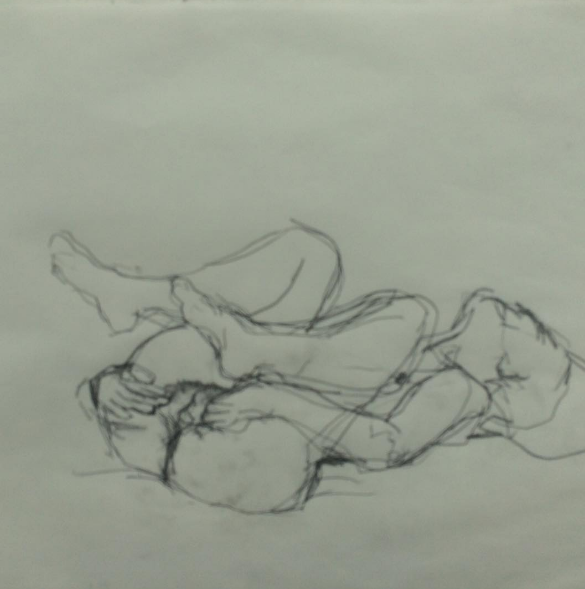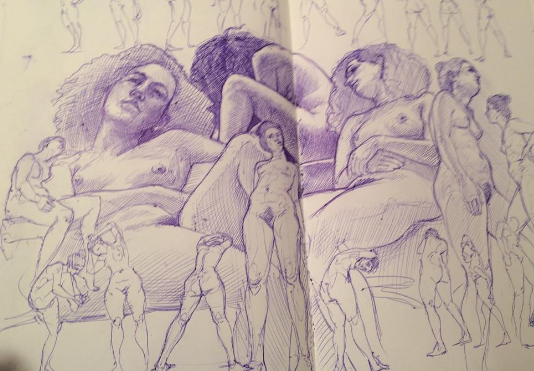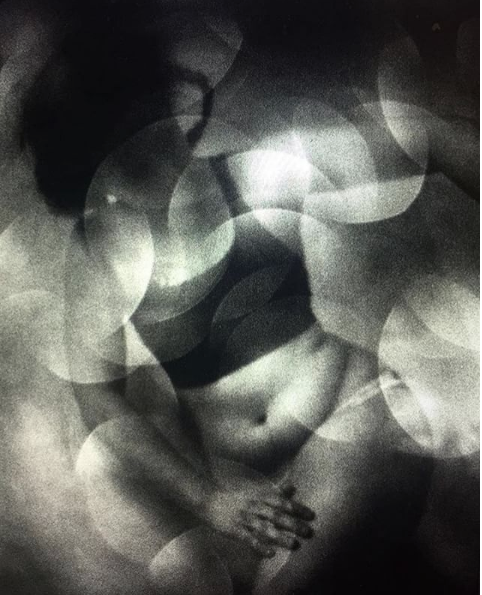
“It was like can I take my clothes off? Where are the folds of my boobs and squiggles and random like nostril holes and weird shit that I can do with my body. I want to see some weird hairs,” Stephanie Guedalia says in the looping lilt her voice takes on when she becomes excited. I’ve only been talking to Stephanie for a few minutes before she begins to wax poetic about the delightful artistry of the body in all its imperfections.
Stephanie is a multimodal artist and art model living and working in Bushwick, Brooklyn. We met when she was posing for a dear friend, and we struck up a friendship based on our shared Jewish heritage, our love of nudity and a blunt streak of feminist thought. It took very little coaxing to get her to discuss her favorite subject, nudity, on the record.
On a blustery day in early spring, we met at Dweebs, my beloved neighborhood coffee shop, which happens to be equidistant from our apartments. Despite the distinct chill in the air, she was relaxed in a short black dress with a floral pattern, her legs bare other than her combat boots and a large camel-colored coat. Her hair, always a bit wild, reminds me of the Carrie Bradshaw monologue about curly hair being a visual representation of a soul that lives outside the box.
As an artist and just as a person, Stephanie loves body exploration. Trained in contact improv as well as dance, much of her work is performance-based, using her naked body as an art tool. “I’m way more interested in bodies than fabric,” Stephanie explained, discussing a recent modeling session with a photographer. He told her to wear whatever she felt comfortable in, but, after the first few pictures, she asked to be photographed nude. “There weren’t enough fat rolls,” she explained animatedly. “I like playing with fat rolls. Where are the creases, the shapes and wrinkles and weird smudges?”

While her interest in nudity is about the aesthetic of the body, it is also about all of the notions and ideas and reactions that nudity, specifically female nudity, brings up. While posing for a college class, she decided to curl up with her knees to her chest and her vagina exposed. Like a Rube Goldberg contraption, she chose a pose, setting in motion reactions from confusion to wonderment and opened up lines of thinking about why a person would do that, inviting the devil-on-your-shoulder, rape-y frat dude voice to wonder “Why is that not asking for it? Is the fact that we are paying money to be in the room the thing that makes it different? Is it because we’re not dressed for a football game? Is it because it’s not night time?” Her interest is in sussing out the details—what makes something asking for it? What detail, from a pair of shoes to a piece of jewelry makes someone naked not nude?

Her work—be it the way she models or her performance pieces—is about extracting and enticing a train of thought. One such piece, preformed at the variety show of works by women and gender nonconforming artists, “Am I Write Ladies,” involved her lying on the floor as though she were passed out— legs splayed open, dress hiked up, vagina out— next to a bowl of condoms and a Do Not Enter sign. She held this position for over three hours. This wasn’t on a stage; it was on the floor amidst the crowd. It was meant to send mixed messages. Is this a sex station? Is she passed out? Does she want it? The art of it, Stephanie explained, was not the act of lying there but the response it provoked, statements from otherwise tactful individuals who said things like, “I don’t get it. Is she asking for it?”

If she chooses to objectify herself on her own terms and with the express purpose of setting up a dynamic, then being objectified is not the same as being disempowered; in fact, it is quite the opposite. It’s about awareness and choice, and “sometimes…you make the choice to be the object,” Stephanie explained. It’s a form of consensual non-consent. “You have to know what nudity means to you,” she makes clear. “For me, when I’m naked I don’t feel like it’s a really vulnerable, intimate moment. For some people taking their clothes off feels like a really intimate, sacred experience. I could imagine, then, that it could feel very different for you, but that’s not what nudity is to me.”

Her relationship to her body has been an evolution in which nakedness was not ok into one where nudity became an active choice. She was raised in a Modern Orthodox Jewish Community where discussions of the female body were about obscuring sexuality. Her mom had a more progressive slant, but the community at large taught young girls about the grossness of men salivating over women’s knees and the need to be demure.
It wasn’t until she began looking for a seminary to study at in Israel that she realized how progressive her community was within the spectrum of orthodox communities. There came a point, however, when she knew there was no way for her to be happy, no way she could have thrived or even just existed were she to stay within the community: “[she] would have been a drained nothing of a person. [She] would have just wilted.”
This radical change and the alienation she felt both within the community and through the process of rejecting it, greatly inform her work. It’s the reason she puts herself out there. Being a kid who was a bit wild and impulsive and doing weird things was hard in a Modern Orthodox Jewish community. You don’t have the weirdo, queer, art kids, to hang out with; it’s just you.
She wants her siblings and anyone who feels confined or isolated and different to know that there is a place and a community where you can feel big feelings and take big risks and it’s OK, and no matter what you do you’re never asking for it. It’s cathartic and empathetic at the same time, telling both the kid inside herself and the other weirdos out there that you aren’t alone.

You can find Stephanie, who also goes by Stevphe, performing at Bizarre Bar and other spaces around Bushwick.
All images courtesy of Stephanie’s Instagram unless otherwise noted.


